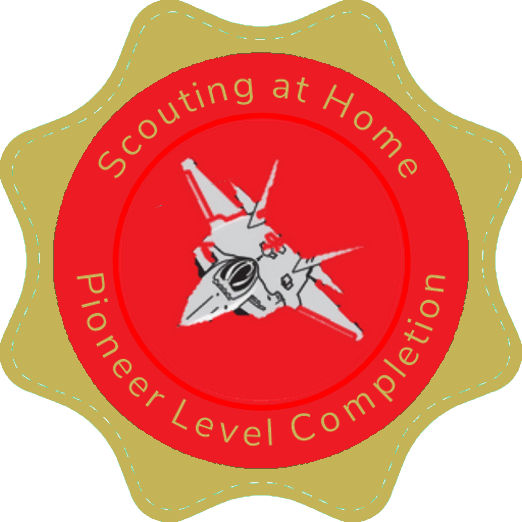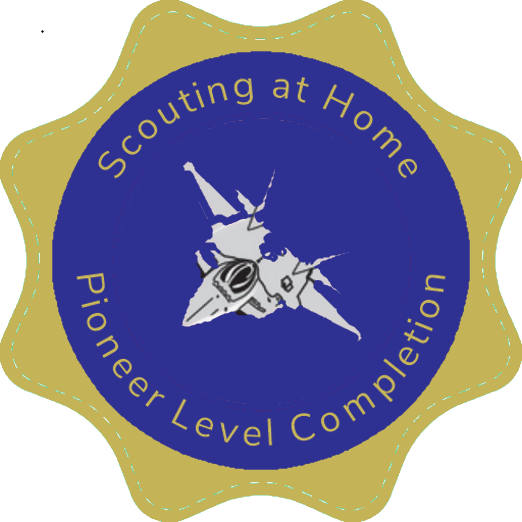Scouting at Home
Congratulations to the Scouts who have completed the Pioneer Level, now Level2, of our recently released online Scout Award Scheme Program. Participants work through the content at their own pace and receive a digital badge of each section completed and a digital certificate when all four sections are completed.
Each level has multiple sections, most are compulsory together with an activity where you have a choice. As you complete each section you will be awarded a digital badge and when you complete all sections you will be awarded a digital completion badge and a digital completion certificate. Register online to obtain enrolment instructions and an enrolment key.
Scout Award Scheme Online Registration - Level 2
The Level 4 is nearing completion, and after review will be put out to a trial group, followed by the Level 3. If you wish to participate in either of these please register on the Online Waitlist Individuals who register on our Online Waitlist using the link below we will advised as their requested level becomes available.
Scout Award Scheme Online Waitlist
Level 2
 Level 2 is based on the old To achieve the Pioneer Air Activities Target Badge. A Scout must complete all of the requirements for No’s. 1 to 3, together with one part from No. 4.
Level 2 is based on the old To achieve the Pioneer Air Activities Target Badge. A Scout must complete all of the requirements for No’s. 1 to 3, together with one part from No. 4.
- Recognition
Be able to recognise by sight four different types of aircraft and know their function. - Weather
- Explain how the three types of weather can have an effect on the flight performance of an aircraft.
- Be able to recognise four signs of changes in the weather in your local area.
- Basic Aircraft Knowledge
- Know the difference between a monoplane and a biplane.
- Using a model or pictures of an aircraft describe the following parts: fuselage, mainplane, tailplane, undercarriage, leading edge, trailing edge, rudder, aileron, tailfin, flaps, trimtab.
- Activity - complete one of the following:
- Take a virtual tour of an airfield find out:
- who owns the airfield
- how many runways there are
- what the runway compass directions are
- what and where the windsock is
- what colour the runway markers are. OR
- With members of your Patrol or other Scouts visit a Scout Air Activities Centre and/or airfield, and find out:
- who owns the airfield
- how many runways there are
- what the runway compass directions are
- what and where the windsock is
- what colour the runway markers are. OR
- Construct both:
- a glider (hand launched) which can fly for ten seconds
- a rubber-band powered model which can fly for 30 seconds. One model of each type required and the use of a kit is permitted. OR
- Have a flight in a light aircraft or glider or hot air balloon.
- Take a virtual tour of an airfield find out:
Level 3

Level 3 is based on the old Explorer Level Air Activities Target Badge. A Scout must complete all of the requirements for No’s. 1 to 3, together with one part from No. 4.
- Recognition
Be able to recognise by sight eight different types of aircraft and know their function. - Weather
- Explain how the three types of weather can have an effect on:
- the flight performance of an aircraft
- take-off and landing of an aircraft
- Have a knowledge of weather pattern in your geographical area
- Find out the difference in the terms “ground speed” and “air speed”, and how they relate to headwinds and tailwinds.
- Explain how the three types of weather can have an effect on:
- Demonstrate an elementary knowledge of:
- the principles governing the theory of flight
- the use in an aircraft of an airspeed indicator, altimeter and magnetic compass
- how to read and apply the 24-hour clock and the phonetic alphabet
- the movable control surfaces of an aircraft and be able to describe their function (e.g. rudder, elevators, ailerons, flaps and trim tab)
- Activity - complete one of the following:
- After visiting a Scout Air Activities Centre and/or an aerodrome, with members of your Patrol or other Scouts draw a map showing the location of:
- location of hangars
- control tower (if any)
- runways, taxiways, and tarmac
- wind socks, and the direction of the prevailing wind
- fuel stores
- navigation aids, and
- emergency facilities
- Take a virtual tour of an aerodrome, and then draw a map showing the location of:
- location of hangars
- control tower (if any)
- runways, taxiways, and tarmac
- wind socks, and the direction of the prevailing wind
- fuel stores
- navigation aids, and
- emergency facilities
- After visiting a Scout Air Activities Centre and/or an aerodrome, with members of your Patrol or other Scouts draw a map showing the location of:
Level 4

Level 4 is based on the old Adventurer Air Activities Target Badge. A Scout must complete all the requirements for No’s 1 to 5.
- Recognition
- Be able to recognise by sight twelve types of aircraft.
- Recognise and describe the difference between the piston engine and the turbojet engine and show that you understand how the power of these units is adapted to propel an aircraft.
- Weather
- Know the various types of cloud and the weather usually associated with each type, and what effect these formations have upon the flight performance of an aircraft.
- Find out some of the factors required to estimate the time it would take to cover a certain distance in the air.
- Show a proficiency in interpreting weather maps.
- Theory
- Describe the correct procedure for radio communication with the control tower or other aircraft on the ground and in the air.
- Do one of the following:
- give a talk to your Patrol or Troop for at least five minutes on Australia’s early aviation history
- compile a report on Australia’s aviation pioneers
- find out, by discussion with a commercial pilot or flight instructor, what the main responsibilities are in performance of their work.
- Airfield Activity - Arrange to visit a Scout or Air Activity Centre and/or aerodrome, and find out:
- who is responsible for the maintenance of airport services
- what is the function of a control tower
- what is the function of an Air Traffic Controller
- what airlines/aircraft use the aerodrome.
- Complete five of the tests from one of the following familiarisation electives, or complete the aeromodelling task.
- Flight Activities
- Light Aircraft Familiarisation
- Learn how to assist correctly in ground handling of an aircraft and find out the safety precautions required whilst refuelling.
- Describe cockpit checks performed by the pilot prior to take-off and prior to the landing approach.
- Describe the primary effect of aircraft controls.
- Have two flights in a light aircraft.
- Know and demonstrate an elementary knowledge of aircraft controls – control column, rudder pedals, throttle, flaps, trim tabs, mixture control.
- With the use of a map, compass and protractor, show how to plot a course between two towns.
- Know the procedure to adopt in the event of an emergency.
- Gliding Familiarisation
- Learn and demonstrate handling and parking.
- Learn and demonstrate launching signals.
- Act as a satisfactory member of a ground-handling crew in an actual landing.
- Know the procedure to adopt in the event of an emergency.
- Have had two flights in a glider.
- With the use of map, compass and protractor show how to plot a course between two towns.
- Aeromodelling - Construct two models selected from the following classifications (use of kit permitted). The models shall have the minimum flight times listed below:
- glider (hand launched) 17 seconds
- glider (hand launched) aerobatics
- rubber powered one minute
- engine powered (maximum 15 seconds motor run) two minutes


